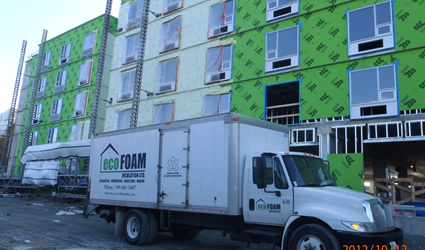Home › Why is spray foam better?
Why is spray foam better?
- It saves you money – Foam is spray applied as a liquid and expands as a foam so it fills every single nook, cranny, crevice, hole, crack, and gap making a perfect air-tight seal every time, regardless of complex framing. It will reduce your heating and cooling costs by up to 50%. Foam has a “Real World” R-Value that is un compromised by external forces like temperature and wind. Fiber Insulations such as Fiberglass (batt) and Cellulose merely slow down convection which accounts for 80% of heat loss. As the temperature drops, convection currents speed up and Fiber Insulations lose their effectiveness. Foam on the other hand stops convection. Wind is not a factor either for Foam due to its continuous air-tight seal.
- It makes your home healthier – Foam improves indoor air quality and comfort. Since it creates a continuous air-tight seal, dust and other exterior pollutants cannot enter the building. Also it does not contain any fibers, loose particles, VOCs (Volatile Organic Compounds) or CFCs (Chloro Fluoro Carbons) that can contaminate indoor air quality. Foam eliminates the presence of air inside your exterior walls which virtually eliminates the possibility of having moisture form and create mold.
- It makes your home quieter – Foam increases comfort by decreasing noise. A building sprayed with Foam is much quieter; it decreases the noise from both the exterior environment and interior mechanical systems. Open cell foam has sound and acoustic properties that are far superior fibreglass batts.
- It helps save our environment – The average Canadian home loses enough air in one day to fill the Goodyear Blimp twice. That is air that you just paid to heat. Spray foam will reduce your carbon footprint by reducing your energy consumption. Foam is environmentally friendly and Closed Cell Foam is made from annually renewable Soybean oil and recycled plastic bottles. It uses a Zero Ozone Depletion Substance (Zero ODS) blowing agent. A building that is insulated and sealed with Closed Cell Foam will also use 50% to 80% less energy, reducing fossil fuel usage and decreasing greenhouse gas emissions. According to the 2003 NRC Survey of Household Energy Use, the average 2000 sq. ft. home can reduce it’s Green House Gase emissions by 4.1 tonnes, the equivalent of taking 676 SUVs off the road by using spray foam insulation to seal the building envelope.

